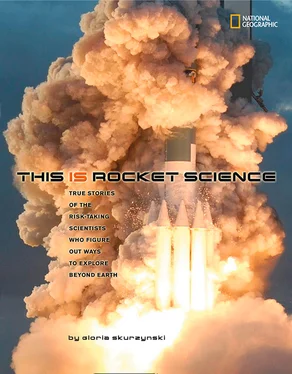THE V-2 ROCKET WAS BUILT AND TESTED AT A GERMAN FACILITY CALLED PEENEMUNDE.
In his 2007 book Red Moon Rising, journalist Matthew Brzezinski describes in detail the launch of a V-2 from the German-occupied Dutch coast. He writes, “Twenty-five seconds had elapsed since liftoff. During that period, the rocket had shed six thousand pounds.” That’s 6,000 pounds of liquid propellant burned off and converted into thrust. “At an altitude of seventeen miles, the turbine shut down, cutting off fuel to the combustion chamber. Now the rocket was a projectile, a forty-six-foot-long artillery shell…moving at 3,500 miles per hour.”
That V-2 rocket reached an altitude of 52 miles before gravity curved it downward to eventually land with a tremendous explosion in London. By the end of the war, of the almost 6,000 V-2 rockets the Germans had built, 3,500 had been launched—40 percent of them aimed at England. The damage was ruinous.
When the war neared its final days, the United States and the Soviet Union both wanted the designs for the V-2 rockets as well as the engineers who’d built them. Entering Germany with their invading armies, Soviet and American intelligence teams began searching through German installations for any V-2 parts and engineers they could find. The Soviet team included Sergei Korolev.
As a teenager Korolev had spent hours watching seaplanes and gliders at a naval airstrip near his home in Odessa, a major port in the Soviet Republic of Ukraine. The pilots grew so used to young Korolev hanging around that they let him work on the planes and even took him for flights. At 17 Korolev joined an amateur aircraft club and later entered college to study aeronautical engineering. After graduation he joined GIRD, a Soviet research group working on rocket propulsion.
Then came horrible times for Korolev. In 1938, in a political purge ordered by the leader of the Soviet Union, Josef Stalin, Korolev was accused of “subversion in a new field of technology” and was sent to concentration camps in Siberia, where he nearly died from beatings and starvation. Later, the Soviets realized the value of his expertise and transferred him to a prison where he could continue his rocket research. In 1944, after he’d gathered V-2 information in Germany, he returned to Moscow and began to design military missiles based on the German rockets. But he was more interested in developing rockets for space travel than for warfare. About one of his designs he said angrily, “The purpose of this rocket is to get there! [He pointed to the sky.] This is not some military toy!”
Конец ознакомительного фрагмента.
Текст предоставлен ООО «ЛитРес».
Прочитайте эту книгу целиком, купив полную легальную версию на ЛитРес.
Безопасно оплатить книгу можно банковской картой Visa, MasterCard, Maestro, со счета мобильного телефона, с платежного терминала, в салоне МТС или Связной, через PayPal, WebMoney, Яндекс.Деньги, QIWI Кошелек, бонусными картами или другим удобным Вам способом.












